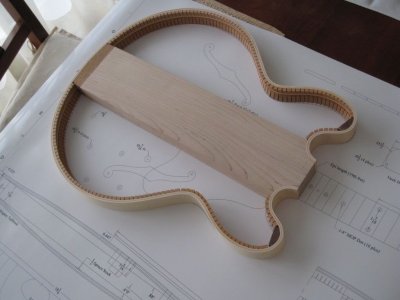pabloman said:
I don't believe the traditional archtop/hollowbody characteristics apply to the Warmoth Mooncaster. Isn't it really more of an extremely chambered guitar with a thick contoured top?
Not at all. The Star/Mooncaster is pretty much the same routing as the most common semi-hollow archtops. An original Starcaster is between a standard semi-hollow and a full-hollow archtop, as the larger pickups required more wood to be removed, the bolt-on neck required less wood to be within the body itself, and the extended controls also demanded more room. The newer Starcasters retain a little more wood in the middle, and the Warmoth Mooncaster is closer to the modern Starcaster reissue than an original Starcaster.
The actual significant differences are in the wood and hardware choices, not the construction itself. An original Starcaster used laminate maple for the whole outer body—typically just 2 laminate layers for the back and top and 3 for the sides—with a block of alder for the center, and a one-piece maple neck with a very light single truss rod and micro-tilt system; the oversized flatmount bridge and Wide Range pickups also took up more space, as I mentioned before, and the materials used for the bridge in particular really helped retain some brightness. The recent reissue uses 3-layer laminate wood all-over, a tune-o-matic and stopbar bridge, quartersawn maple for the neck and a much heavier-duty dual truss rod and 4-bolt mount. The Warmoth Mooncaster saves even more of the center wood by using the more common, smaller humbuckers, and the wood is whatever you like, though they do insist you have a laminate top of some form; liek the reissues, the tune-o-matic and stopbar combination typically gives you a little less treble retention compared to the outsized flatmount of the originals.
For comparison, the vast majority of other semi-hollow archtops use laminate maple of various kinds, usually with a maple center block, typically around the same size as the original Starcaster had. (Reissues'/Mooncasters' blocks being a tiny, tiny fraction larger.)
The upshot is that the Warmoth body should, in theory, carry
very fractionally more treble than a reissue Starcaster, assuming you were to use maple for the whole guitar and you gave them comparable electronics and hardware. An all-maple Mooncaster should—again, in theory and assuming you equalise everything as much as possible—be very fractionally warmer than an original Starcaster.
With a 25.5" scale maple neck, I would expect a mahogany-bodies Mooncaster to remain a little snappier than common set neck, 24.75" scale archtops, but with a 24.75" scale neck—let alone a mahogany one—the tone isn't going to be much different from an ES-335 style of construction. The bolt-on should mean the neck pickup has a little more treble to it, but the bridge pickup will be about the same; remember, the bridge and bridge pickups on most archtops are rooted firmly in a solid block of maple, not alder like a Starcaster or god-knows-what with a Mooncaster.
So, if we were to take a Mooncaster body made of mahogany with a maple laminate top, and put on a 24.75" mahogany neck, you're going to get a much warmer tone than any archtop you'd usually handle. The neck pickup may—
may—retain similar clarity to an maple-bodied archtop, but I wouldn't want to bet on it, and you can say goodbye to any treble from the bridge pickup, if you're not severely compensating with your electronic choice. A mahogany back, sides, and middle is a very different tone from a ES-335's or Dot's laminate maple outer and solid maple inner.
For reference, there
is an archtop—sort of—which uses mahogany for the outer and middle of the guitar: the Epiphone 'Kat' family. They use a 2- or 3-piece solid mahogany body, routed out like a Thinline Telecaster, and then have a top added which is a mahogany & maple laminate, with an additional maple veneer for some finishes. Their bodies are a little broader than a Les Paul but smaller than a Dot, Casino or ES guitar, and they are a little thicker, at just over 2" deep. They use a set-in, 24.75" scale, 3-piece flame maple neck and rosewood fretboard. The 'WildKat' model has a tune-o-matic and bigsby, with P-90 pickups, and the 'AlleyKat' model uses a tune-o-matic and stopbar, with humbuckers.
In terms of overall construction, it is those Epiphone Kat guitars which are closest to a mahogany-bodied Warmoth Mooncaster; both have the slightly looser resonance of the simpler, less heavily-laminated construction, both would have mahogany for both the outer construction and the center block, and their default hardware and electronic layout is more similar. The Mooncaster will still have a larger hollow area, though—it's still a broader body style—and, though one is a bolt-on and the other is a set neck, the rigid 3-piece maple of the Kat guitars would balance out the mahogany used for this hypothetical Mooncaster.
And I can tell you right now that even the brighter 'WildKat', with its bigsby and P-90s, is one of the warmest, thickest, smoothest, and muddiest guitars you will ever play. A Mooncaster with a similar degree of mahogany dominance is not going to have any treble to speak of, without winding some severely bright pickups and cutting out some of the controls.
nullref said:
A Gibson CS-336 starts out as a solid piece of mahogany. And that guitar is simply amazing...
That's a very, very different type of guitar to any other archtop of a similar appearance. The body is significantly smaller than ES-335s/Casinos/etc, and it has so little wood taken out of it that it has more in common with the '72 style of Fender Thinline, or the Epiphone Florentine Les Paul, than even a semi-hollow archtop, let alone a fully-hollow body. Even the Epiphone Kat guitars which I mentioned above have more in common with a standrad archtop than the CS-336.





